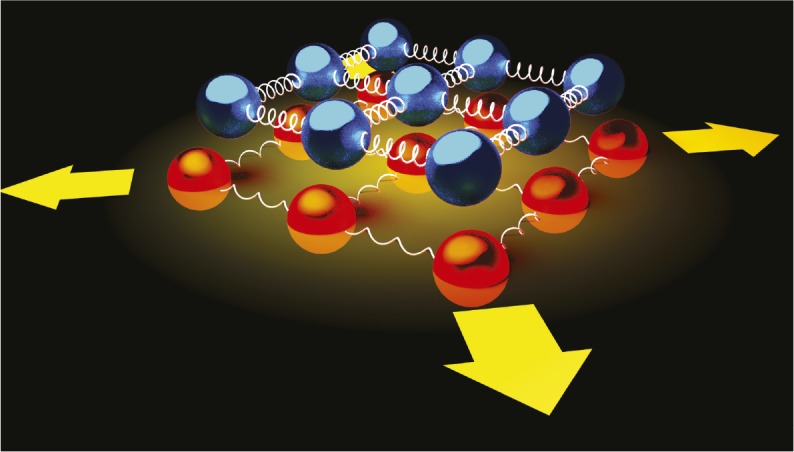Gecko evolution and human-caused isolation

Common gecko of the Brazilian Cerrado. Image courtesy of Guilherme Santoro (Universidade de Brasília, Brasília, Brazil).
Previous studies have found that human-caused ecosystem changes can drive rapid adaptive changes in local organisms. Mariana Eloy de Amorim et al. (pp. 8812–8816) explored how approximately 15 years of isolation affected the diet and morphology of a termite-eating gecko (Gymnodactylus amarali) in the Brazilian Cerrado, a biodiversity hotspot. The construction of a hydroelectric dam flooded a Cerrado valley in 1997, isolating G. amarali populations on islands. The authors focused on five newly created islands and five mainland locations. Compared with G. amarali on the mainland, G. amarali on the islands eat larger termites as well as prey with a wider range of body sizes. Island G. amarali also have proportionally larger heads than mainland G. amarali, enabling island geckos to eat larger prey without a large increase in energy requirements. Moreover, the adaptive shifts occurred independently on each island, likely driven by similar changes in community structure. The authors suggest that the island G. amarali may consume larger prey due to the likely increase in the availability of larger prey following the extinction of four other termite-eating lizard species—all of which were larger than G. amarali—on the islands. According to the authors, island G. amarali represent rapid and parallel adaptive change to human-caused ecological disturbance. — L.C.
Climate and suicide in India

Farmers in Madhya Pradesh, India. Image courtesy of Flickr/Rajarshi Mitra.
Suicide claims more than 130,000 lives in India each year, but the underlying causes are poorly understood. One hypothesis links suicide to extreme climate events that damage crop yields, increasing farmers’ debt burdens. To test this hypothesis, Tamma Carleton (pp. 8746–8751) analyzed 46 years’ worth of suicide records from India’s National Crime Records Bureau along with official data on crop yields and high-resolution climate data. Annual suicide rates increased with daily temperature during the growing season, such that the number of suicides rose by 70 per day for each 1 °C temperature increase above 20 °C. During the growing season, declines in agricultural yields at high temperatures mirrored the rise in suicide rates at high temperatures. By contrast, neither suicide rates nor agricultural yields were correlated with temperature outside the growing season. High growing season temperatures were associated with elevated suicide rates notonly for the same year, but for up to 5 years in the future, and the temperature sensitivities of crop yields and suicides were correlated across regions. According to the author, the results link climate-induced crop failures with farmer suicides. — B.D.
Thermal strain and organic semiconductor performance

Thermal expansion at interfaces in organic devices.
Electronics derived from organic semiconductors are inexpensive and easy to fabricate, accommodate a wide variety of forms, and exhibit desirable properties such as malleability. Despite these advantages, devices based on organic semiconductors fail to achieve sufficient levels of electrical performance due to poorly understood processes that undermine the mobility of charge carriers at the functional interface between the semiconductor material and the gate dielectric. Yaochuan Mei et al. (pp. E6739–E6748) report that one source of inefficiency likely arises from mismatched coefficients of thermal expansion (CTE) in consecutive layers, which induce inhomogeneous strain in the organic material. The authors’ experiments and models suggest that thermal strain generates trapping states that reduce charge carrier mobility, and that strain-induced trap density is proportional to the magnitude of the CTE mismatch. Based on this relationship, the authors suggest that a high-quality semiconductor layer alone is insufficient to overcome performance degradation due to CTE mismatch. An ultrathin CTE buffer layer designed to minimize CTE mismatch protects the semiconductor from thermally induced strain and achieves carrier mobility consistent with the intrinsic material properties, according to the authors. — T.J.
Sleep and racial differences in cardiometabolic disease

Sleep patterns and racial differences in CMB disease. Image courtesy of Pixabay/Olichel.
Sleep deficiencies have been linked to cardiometabolic (CMB) disease, with African American (AA) adults experiencing a higher prevalence of both sleep problems and CMB disease than European American (EA) adults. However, the reasons underlying these racial health disparities are unclear. David Curtis et al. (pp. 8889–8894) examined sleep patterns and biomarkers for CMB in 426 AA and EA participants, who were on average 56 years of age. Over seven nights, the authors recorded participants’ total sleep time and sleep efficiency, which is defined as the percentage of time in bed spent asleep. Seven biomarkers, including blood pressure and waist circumference, were used to index CMB risk, and sociodemographic characteristics and relevant health behaviors were also taken into account. The findings revealed that AAs slept less and exhibited lower sleep efficiency than EAs. On average, AAs experienced 341 minutes of sleep and 72.3% sleep efficiency, compared with 381 minutes and 82.2% sleep efficiency for EAs. Moreover, AAs exhibited elevated levels of several biomarkers associated with CMB risk. Overall, the differences in sleep patterns between AAs and EAs accounted for more than one-half of the racial differences in CMB risk. According to the authors, the findings might have implications for reducing racial disparities in CMB disease. — C.S.


